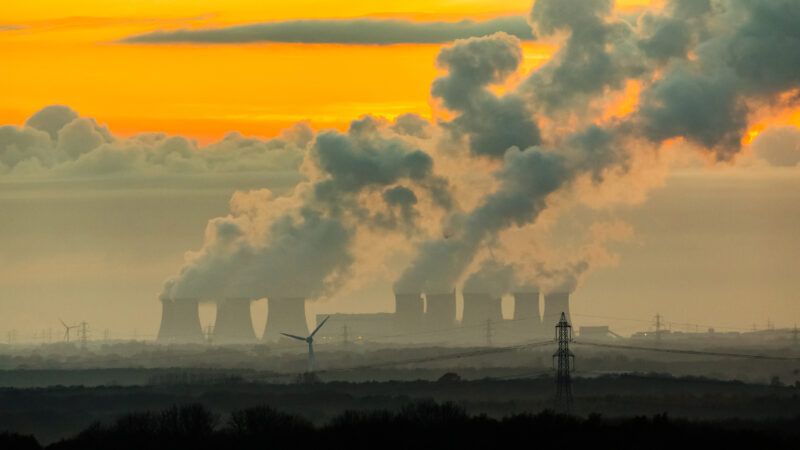The EPA's Power Plant Emissions Rules Are Unworkable, Says Trade Group
The Edison Electric Institute submitted comments clarifying that although it supports the EPA's goal of decarbonization, the technologies being presented are not sufficiently proven effective.

In May, the Environmental Protection Agency (EPA) proposed new regulations for power plants' greenhouse gas (GHG) emissions, like carbon dioxide. Under the new rules, coal- and gas-fired plants that wanted to stay open would have to lower their GHG output by 90 percent within the next decade or otherwise switch to alternative forms of energy production. The rules were part of President Joe Biden's pledge "to create a carbon pollution-free power sector by 2035."
This week, the U.S. electric industry told the EPA that its rules are counterproductive and based on unproven technology.
The Edison Electric Institute (EEI) is a trade association that "represents all U.S. investor-owned electric companies," providing "electricity for nearly 250 million Americans" across all 50 states and Washington, D.C. In a statement on Tuesday, EEI President and CEO Tom Kuhn said, "EEI and our member companies support regulations for GHG emissions" and that "we share EPA's long-term clean energy vision for our sector." He said EEI member companies had significantly lowered their carbon outputs below 2005 levels "not because they are forced to by federal regulation, but instead because they are committed to delivering resilient clean energy to their customers."
But in comments filed with the EPA regarding its new rules, the EEI expressed concerns about the ability to comply with Biden's goal. "Electric companies are not confident that the new technologies EPA has designated to serve as the basis for proposed standards for new and existing fossil-based generation will satisfy performance and cost requirements on the timelines that EPA projects," it says. "This will impact electric companies' efforts to deliver affordable and reliable electricity to customers."
One of the primary methods of GHG mitigation is carbon capture and storage (CCS) technology, which involves removing carbon from the air and injecting it into underground wells. The EPA's rules are expected to incentivize CCS among power plants. Natural gas plants can also inject cleanly-derived hydrogen into their pipelines to produce energy with fewer emissions than gas alone. Under the EPA rules, plants must install a carbon capture system by 2035 or achieve 30 percent of their output via hydrogen blend by 2032.
But EEI contends that the "EPA has failed to show that either CCS or the hydrogen blending requirements are adequately demonstrated and can be BSER," or best system of emissions reduction. Further, "the efforts by EEI member companies as well as universities, [the U.S. Department of Energy], and international organizations and governments have not yet resulted in CCS systems that perform at the levels that EPA would require for compliance." Even the EPA's cited studies "highlight that the technology remains in the development and demonstration phase, not the commercialization and deployment phase, and that the capture levels proposed are not yet achievable."
EEI goes to great pains to underscore that it supports the EPA's decarbonization goal—it refers to CCS as "an important emerging technology"—but it hopes to do so on a more realistic timeline. The EPA claims that CCS will become cheaper and easier to install due to the rule, as "companies with the expertise to install complex emission control equipment can rapidly ramp up capacity in response to a regulatory driver." But the EEI counters that "the numerous examples of planned and delayed or abandoned [CCS] projects are proof of the opposite." The EPA is currently sitting on dozens of pending applications to build CCS wells, and that number will only increase as they become effectively mandated.
"Moreover," EEI continues, "most projects to date have received significant federal and other governmental funding, which highlights that the costs of the technology to the industry—and customers—is not yet acceptable."
EEI's comments make the case for a more market-driven approach to green technology. The EPA estimates that while U.S. GHG emissions have decreased 2 percent since 1990, emissions from electricity production have declined 15 percent over the same period "due to a shift in generation to lower- and non-emitting sources of electricity generation and an increase in end-use energy efficiency."
Show Comments (29)